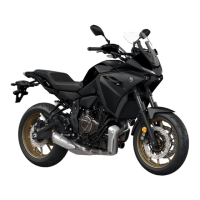
Do you have a question about the Yamaha TRACER 7 and is the answer not in the manual?
| Displacement | 689 cc |
|---|---|
| Bore x Stroke | 80.0 mm x 68.6 mm |
| Compression Ratio | 11.5:1 |
| Maximum Torque | 67.0 Nm (6.8 kg-m) @ 6, 500 rpm |
| Fuel System | Fuel Injection |
| Ignition System | TCI |
| Transmission | Constant Mesh, 6-speed |
| Final Drive | Chain |
| Rear Brake | Hydraulic single disc, Ø 245 mm |
| Front Tyre | 120/70 ZR17M/C (58W) |
| Rear Tyre | 180/55 ZR17M/C (73W) |
| Overall Length | 2, 140 mm |
| Overall Width | 840 mm |
| Seat Height | 835 mm |
| Wheelbase | 1, 460 mm |
| Minimum Ground Clearance | 140 mm |
| Wet Weight | 196 kg |
| Fuel Tank Capacity | 17 litres |
| Lubrication System | Wet sump |
| Clutch Type | Wet, multiple disc |
| Starter System | Electric |
| Frame | Diamond |
| Front Travel | 130 mm |
| Trail | 90 mm |
| Rear Travel | 142 mm |
| Engine Type | Liquid-cooled, 4-stroke, DOHC |
| Maximum Power | 72.4 PS (53.0 kW) @ 8, 750 rpm |
| Front Suspension | Telescopic fork |
| Rear Suspension | Swingarm, (Link suspension) |
| Front Brake | Hydraulic dual disc, 298mm |
| Oil Tank Capacity | 3.0 litres |
| Overall Height | 1, 290 mm |
Owner's responsibilities for safe operation and proper riding techniques.
Importance of wearing appropriate safety gear like helmets, jackets, gloves, and boots.
Hazards of carbon monoxide and precautions to avoid poisoning.
Guidelines for safe loading of cargo and accessories on the motorcycle.
Risks associated with aftermarket parts and modifications affecting safety.
Diagram and identification of major components on the left side of the motorcycle.
Diagram and identification of major components on the right side of the motorcycle.
Identification and location of handlebar controls and dashboard instruments.
Explanation of the quick shifter function for clutch-less upshifts.
Details about the CCU for smartphone connectivity and app features.
Explanation of the anti-theft immobilizer system and key handling.
Operation of the main switch for ignition, lighting, and steering lock.
Description of left and right handlebar switch functions.
Explanation of dashboard indicator and warning lights like ABS, Immobilizer.
Details on the main display screen layout, themes, and displayed information.
How to navigate and operate the vehicle's menu system.
Operation of clutch lever, shift pedal, and brake controls.
Explanation of the Anti-lock Brake System (ABS) operation and warnings.
Fuel tank cap, fuel type, and refueling safety precautions.
Information on seat, helmet holder, storage, and windshield.
How to adjust front fork and rear shock absorber settings.
Using auxiliary DC jack, USB jack, and luggage strap holders.
Sidestand operation and ignition circuit cut-off system.
Pre-operation checks for fuel level, line, and hoses.
Pre-operation checks for engine oil and coolant levels.
Pre-operation checks for front and rear brakes, clutch, and fluid.
Pre-operation checks for wheels, tires, drive chain, and pedals.
Pre-operation checks for control cables and sidestand operation.
Ensure chassis fasteners are tight and check switches.
Guidelines for the engine break-in period to ensure longevity.
Step-by-step instructions for starting the motorcycle engine.
How to shift gears, start out, accelerate, and decelerate.
Advice on fuel efficiency and safe parking procedures.
Location of the tool kit and introduction to maintenance charts.
General maintenance and lubrication schedule for various components.
Checks for spark plugs, oil, and coolant.
Procedures for changing engine oil, coolant, and brake fluid.
Replacing air filter and checking engine idling speed.
Tire inspection, pressure, and wheel checks.
Checks for brake pads, fluid, levers, switches, and hoses.
Checking drive chain slack, cleaning, and lubrication.
Lubricating control cables, levers, and pivots.
Checking front fork, rear suspension, steering, and wheel bearings.
Battery care, charging, and fuse replacement procedures.
Checking vehicle lights and replacing license plate bulb.
General troubleshooting guide and steps for engine overheating.
Precautions for cleaning matte finished parts to avoid damage.
Guidelines for regular cleaning and special care for winter.
Detailed instructions for washing the motorcycle safely.
Recommendations for storing the vehicle and long-term preparation.
Importance of vehicle, engine, and model identification numbers.
Location of diagnostic connector and vehicle data recording.
Regulations regarding tampering with the noise control system in Australia.
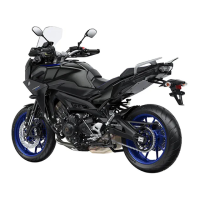
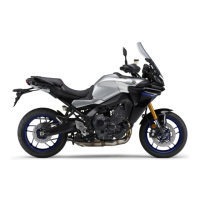
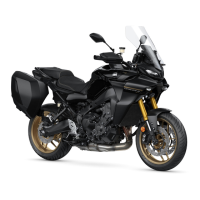
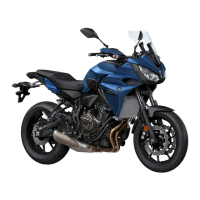
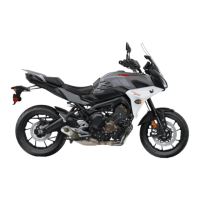
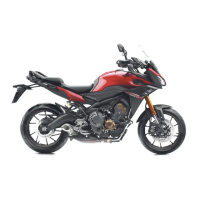
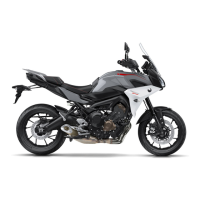
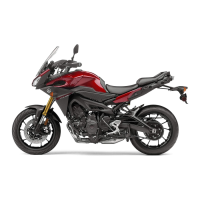



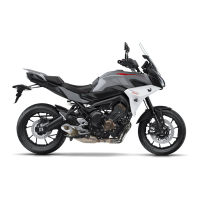
